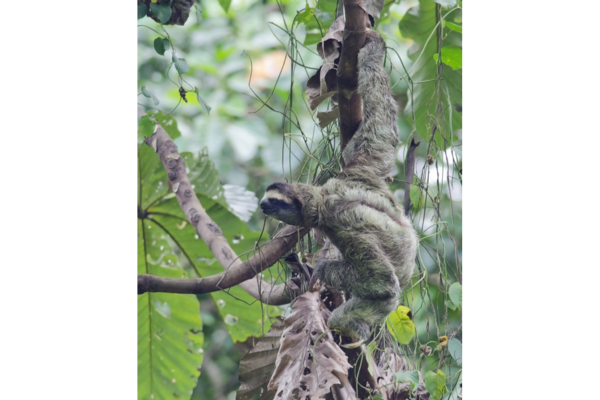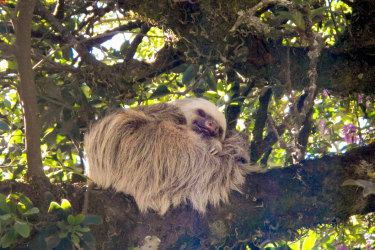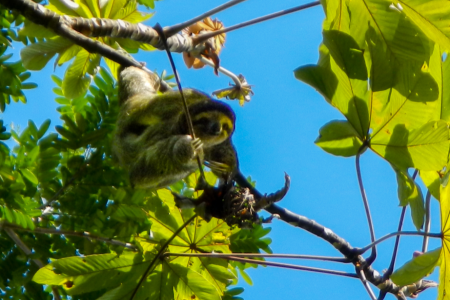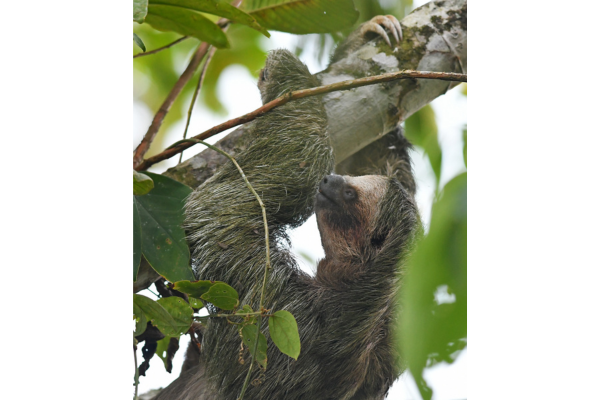These tree-dwelling, leaf-eaters from Central and South America experience life and movement within an unusual regime of time and space, unlike any other animal. Perhaps because of this, sloths are able to support other organisms on their hair. Teaming with life, they have been characterized as ‘mobile ecosystems’ or moving islands of biodiversity, with still much to be discovered!

Notice the greenish, algae covered fur on this
Brown-throated Three-toed Sloth in Panama
(Photo by: Josh Vandermeulen)
Brown-throated Three-toed Sloth in Panama
(Photo by: Josh Vandermeulen)
Like the canopy structure of a rainforest, or layers of a rich grassland, sloth hair provides a framework and micro-climate for an extremely diverse and exclusive community of up to 150 organisms including algae, fungi, bacteria, and arthropods like moths, beetles, sandflies, triatomine bugs, lice, mites, and ticks! Sloth hair has unique cracks and grooves that absorb water and support the growth of algae that often turns them green but more importantly, they function together as the foundation of the mobile ecosystem.
At least 20 different types of algae have been found on sloths, accounting for about 3% of their biomass. Some algae are unique to sloths and found nowhere else on the planet. But does this fur ecosystem benefit the sloth in any way?


Brown-throated Three-toed Sloth eating Cecropia tree leaves in Tortuguero
National Park, Costa Rica
(Photo by: Mike Kent)
National Park, Costa Rica
(Photo by: Mike Kent)
Algae may benefit sloths by providing camouflage from Jaguars, Ocelots, and Harpy Eagles; as a sunscreen; or even as a nutritional snack. It has even been proposed that chemicals produced by sloth hair microbes may act to repel Azteca ants, fierce defenders of Cecropia trees, whose leaves sloths also savour.

Brown-throated Three-toed Sloth? Look carefully!
They look like dried leaves stuck on or in the fur
(Photo by: Josh Vandermeulen)
Another group of unique and found-nowhere-else organisms are the sloth moths. It is thought that sloths, sloth moths, and algae are in a three-way symbiotic relationship. There are 5 known species of sloth moth that have evolved to rely exclusively on sloths for their lifecycle. Adult moths make their home in sloth fur where they live out the entirety of their lives feeding and searching for a mate. On the weekly sloth bathroom-break-bus, female moths hitch a ride to deposit their eggs in the sloth's feces. Once hatched the moth larvae feed on sloth poop until they pupate into adults and fly up to the canopy to find a sloth to start the process all over again. It is postulated that moths that die in a sloth's fur are digested by sloth fur fungi, who convert the moth corpses into usable minerals that help algae grow, which in turn the sloth snacks on.
It sounds totally unbelievable, and there is certainly still much to be discovered. On your next Quest Nature Tours trip be sure to give the trees of the tropical rainforests of Central and South America a closer and more inquisitive inspection so that you can discover these mobile ecosystems of biodiversity yourself!



